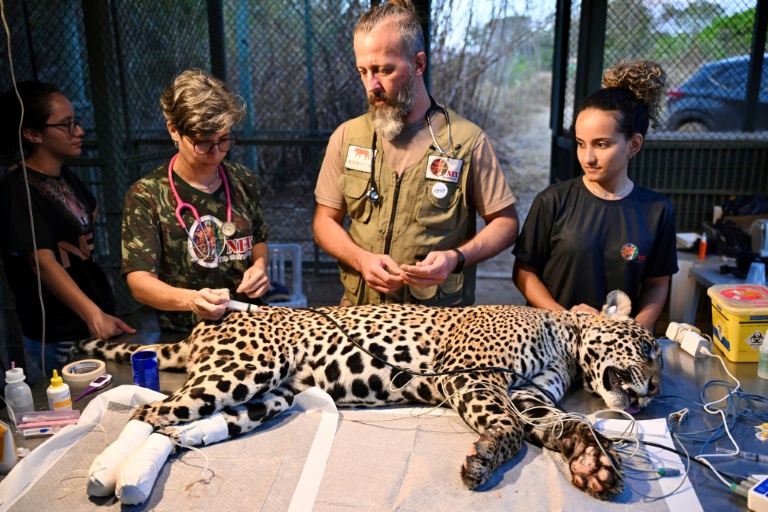At a big cat sanctuary in Brazil, a veterinarian carefully treats the wounds of a jaguar affected by wildfires raging in the world’s largest tropical wetland.
While the animal is expected to recover, her home in the Pantanal continues to burn.
The Pantanal, located south of the Amazon in the state of Mato Grosso do Sul, has the highest density of jaguars in the world. It is also home to millions of caimans, parrots and giant otters.
Brazil is in the throes of a historic drought that experts link to climate change and has led to what authorities are calling a “fire pandemic.” Some 6.7 million hectares (16.6 million acres) have burned in the Brazilian Amazon so far this year, representing 1.6 percent of the rainforest.
The fires are also ravaging the Pantanal, a UN World Heritage site. According to the National Institute for Space Research, 1,452 fires have broken out so far in September, almost four times as many as in September 2023.
Pollyanna Motinha, a veterinarian at the Nex NoExtinction animal shelter on the outskirts of Brasilia, says she is increasingly seeing animals “at the top of the food chain, like jaguars” being injured in forest fires.
“It’s something that didn’t happen very often in the past,” she told AFP.
The jaguar, the largest cat in the Americas, is listed as “near threatened” by the International Union for Conservation of Nature.
The Pantanal jaguar, found along the banks of the Paraguay River, weighs an average of 100 kilograms (220 pounds).
It is estimated that there are fewer than 2,000 left in the region.
The jaguar, named Itapira, was found in a drain near the town of Miranda, an area hard hit by the flames, with all four of her legs burned.
Despite her injuries, the two-year-old, 130-pound cat should be approached with caution.
Before being treated, she is anesthetized with tranquilizer darts.
Motinha, her husband and fellow veterinarian Thiago Luczinski and two students then clean her wounds and wrap her paws in bags to apply ozone. Ozone has a disinfecting and healing effect.
After a month of almost daily care, Itapira’s condition has improved.
In the wild, the burns left her unable to use her claws to hunt caimans and capybaras, a large, semi-aquatic rodent native to South America.
“If she hadn’t been brought here, if she had remained in the wild, she probably wouldn’t be alive or would be in a deplorable state,” Luczinski said.
But caretakers are concerned about the jaguar’s future.
“This animal is now safe, but she is going back into an area where fires are still prevalent,” he said.
Another female jaguar that suffered burns in a previous major fire in the Pantanal in 2020 was unable to return from Brasilia.
Her legs were so badly burned that she lost the tendons that move her claws, explains Silvano Gianni, co-founder of Nex NoExtinction.
She has since had two more cubs in captivity, one of which will be released back into the wild.
rsr/cb/acb







